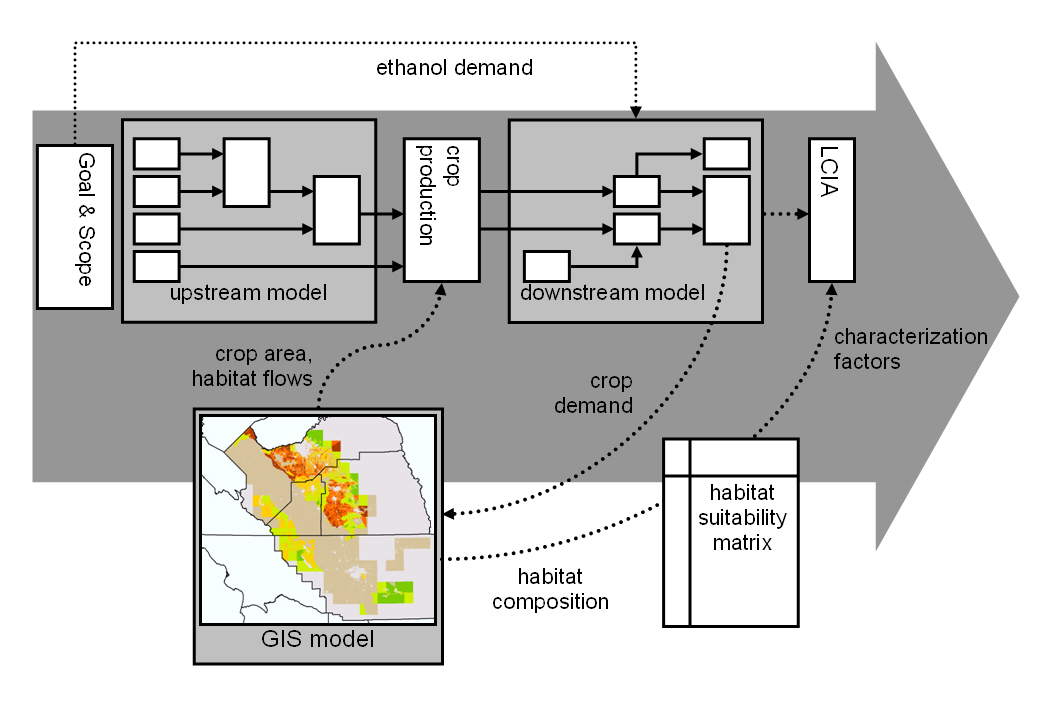
What's New
Research & Projects Publications
People
Data
Links
UCSB Biogeography Laboratory Projects
Coupling LCA and GIS for biodiversity assessments of biofuel production
Principal Investigator: Dr. Roland Geyer
Co-Principal Investigators: Dr. David Stoms and Dr. Frank Davis
Funding agency: University of California Energy Institute
Project period: July 1, 2007 to June 30, 2009
Project summary:
Overview
Life cycle assessments of product systems or changes in product systems are supposed to be comprehensive, i.e. include all relevant life cycle stages and environmental concerns. There is widespread agreement that assessing impacts from land use, in particular on biodiversity, is therefore an important part of LCA. This is particularly true for agricultural product systems such as food or fuel crop production. At the same time, biodiversity is one of the least mature impact categories in LCA. In part, this is caused by the fact that the computational structure of inventory modeling and impact assessment is typically non-spatial, while biodiversity assessments require the collection and analysis of spatial data.In order to advance theory and practice of biodiversity assessments within LCA, we developed a framework for the coupling of LCA and GIS, and applied it to the example of biofuel production in California’s San Joaquin Valley. We studied ethanol production from different fuel crops and for a range of total output levels. Soil information is combined with other data to generate spatially explicit and non-linear process inventories for all fuel crop production scenarios. The biodiversity assessments of the fuel crop production scenarios are based on spatially explicit habitat information for native terrestrial vertebrates. Different biodiversity impact indicators are calculated based on biodiversity concepts such as species richness and evenness, and habitat naturalness and rarity. All exhibit space-dependent and non-linear behavior, which shows that non-spatial, linear analysis is not suited for such biodiversity assessments. We finally used our biodiversity indicators to study the trade-offs between biodiversity and other impact categories, such as climate change. Overall, we find that combining LCA with GIS is relatively straightforward and has large potential to enhance life cycle assessments of product systems.
Project Publications:
Stoms, D. M., R. Geyer, J. P. Lindner, F. W. Davis and B. Wittstock. In preparation. Coupling LCA and GIS for biodiversity assessments: Part 1 Inventory modeling of ethanol production scenarios. To be submitted to International Journal of Life Cycle Assessment.Lindner, J. P., R. Geyer, D. M. Stoms, F. W. Davis and B. Wittstock. In preparation. Coupling LCA and GIS for biodiversity assessments: Part 2 Impact assessment. To be submitted to International Journal of Life Cycle Assessment.
Lindner, J. P., D. M. Stoms, R. Geyer, F. W. Davis and B. Wittstock. Coupling of LCA and GIS for biodiversity assessment of biofuel production. Paper presented at the Life Cycle Assessment VIII Conference, Seattle, October 2, 2008. Link to slides here

